Cantaloupe is a vine that producing a huge & delicious crop. One day I thought can I grow cantaloupes in a tomato cage, instead of just running them on the ground. I’ve done a lot of experiments and research on it. So this article is all about growing cantaloupe in tomato cages.
Here are the steps to grow cantaloupes in a tomato cage.
1. Prepare the soil and ground
2. Install the tomato cage
3. Sow or transplant cantaloupes
4. fertilize the soil
5. Train cantaloupes to run on the trellis
6. Harvest the cantaloupes
From my experience of growing cantaloupe vertically on tomato cages, it’s not that hard to do. It’s fun.
To know, how to do it and to have the best tips to care cantaloupes, keep reading.
Table of Contents
Requirements to grow cantaloupe in tomato cages
In order to grow this fruit in tomato cages. we have to know about what are the requirements we are having.
So let’s jump onto it.
A tomato cage
This is the main requirement of this process. And this is the support we use to run the cantaloupe vine vertically.
Usually, many gardeners use large trellises to grow cantaloupe and melons vertically.
But using a tomato cage is cheap and recyclable for you.
You can use old tomato cages that you had used with tomatoes, to grow cantaloupe.
Many varieties of fruits and vegetables in cucurbits family needs a large area to grow.
So instead of just running them on the ground, leaving them to run on a trellis or a tomato cage is a fine thing to do.
Also, It’s dragging off the cantaloupe plants from rotted and water-logged leaves.
However, you should have to use at least 6 feet tall tomato cage supportive trellis to grow cantaloupe. That’s because this plant is growing up for too long comparing to other vines.
You can find 6 feet tall tomato cages, which are way cheaper than trellises, from here on Amazon.
But if you are willing to use your old tomato cages, maybe you’ve to combine two of them and make sure that is tall enough as a trellis for cantaloupes.
Also if you like to be a DIY guy, this video will guide you about how to make a cantaloupe trellis on your own.( a tomato cage)
Now you are read with the tomato cage, which is the main requirement to grow cantaloupe in a cheap trellis.
Environmental requirements
You should have to care about what are the environmental conditions that cantaloupes expecting.
If you can provide them, you will definitely get honored by some big, delicious cantaloupes.
Because cantaloupe is a fruit variety in the Cucurbits family, they are likely to grow in full sun.
So you need to provide that warm and sunlight condition for all around the day or at least for 8 hours per day.
Here’s the point
Cantaloupes are growing well in the temperature between, 65 F to 90 F.
When It’s getting around 60 F, you can’t expect a great yield from them.
These warm loving cantaloupes won’t satisfy with just getting sunlight on the plant.
They also need a warmly soil to perform their best growth.
Many species of cantaloupes are often facing the disease of water-logged and fungal attacked leaves.
That’s because of they hate the wet on their leaves.
Mostly, this occurs on rainy days, if you are growing cantaloupes running on the ground.
This happens because the top layer of leaves will work as an umbrella for the bottom layer. So they will become wet while pushing them into a disease.
But luckily, you may not be going to face this challenge anymore when you’re growing cantaloupes, melons and Cucurbit family vegetables vertically on trellises or in tomato cages.
Even though you know that cantaloupe is a warm loving plant, don’t overdo it.
Leaving off them in extremely hot weather like summer, the leaves, stem, fruits, flowers and roots could be dry out from the unnecessary heatwave.
By considering all of the above facts, you have to care about how much sunlight will your cantaloupe or melon plant getting.
In my point of view, as a summary I would like to say, spring is the perfect season to grow sweet cantaloupes.
A location to plant
When you are going to plant a crop, you’ve several locations to plant them in your garden.
For example, you can plant them in the ground, in a raised bed or in a container.
And the attractive thing is you can grow many crops including cantaloupes and melon on those every location while using a trellis or a tomato cage.
Now I’m going to hand over you to choose where should you grow cantaloupes vertically.
This poll will help you on that.
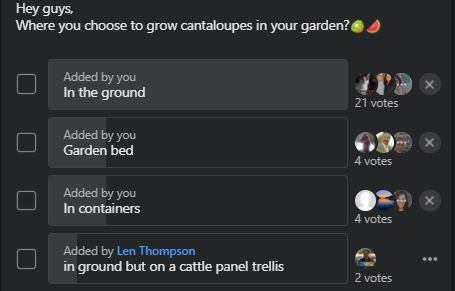
Now I think you may choose the correct decision.
However, as regards this poll that ran on Facebook, many of the gardeners like to grow cantaloupes on the ground.
Maybe space is the main reason for choosing the ground to grow cantaloupes.
But also, there is another reason they feel comfortable with choosing the ground level when they growing cantaloupes and melons.
That is the ability to give enough room to grow deeper roots.
As I mentioned before, especially for the plants like watermelon, cucumbers and cantaloupes have an extended root system than any gardening crop.
So instead of growing cantaloupes in a container, growing them in the ground is 10 times better.
But even the garden bed option has got fewer votes, still, it’s a fine location to grow cantaloupes in tomato cages rather than just trapping it in a pot.
My final recommendation for you, as regrading to this poll is use ground or the garden bed to grow cantaloupes in tomato cages.
Don’t grow cantaloupes in pots, even you’ve not enough space in your garden or when you are growing melon indoor.
But remember, you will also required a trellis or a tomato cage when you grow watermelon and cantaloupe in containers.
Seeds or transplants
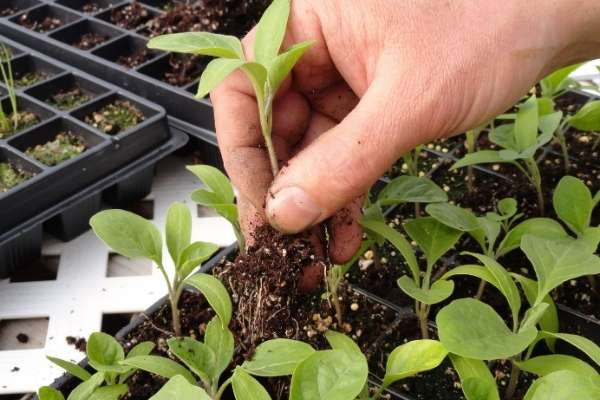
In order to grow cantaloupes, you have two different options for planting them.
That is sowing seeds and transplanting cantaloupes.
Actually, there is no rule in choosing them. Both different options can be used to grow cantaloupes in a tomato cage.
I’d like to recommend you transplanting cantaloupes in the spring if you are living in a cold area.
You can easily, sow some seeds 3 weeks before the last frost date, in paper cup or sow multiple seeds in a see tray.
Then you can use the to transplant in the early spring.
If your area is good enough with the weather you can just sow cantaloupe seeds from the beginning of the spring.
When you’re sowing seeds, you can cover it white colour glass bottle, which works as a little greenhouse. It will encourage cantaloupe seeds to germinate quickly.
We have discussed about the main requirements you will need.
Now let’s jump right in to know about the exact process of growing cantaloupe on tomato cages.
Step 1: Prepare the soil
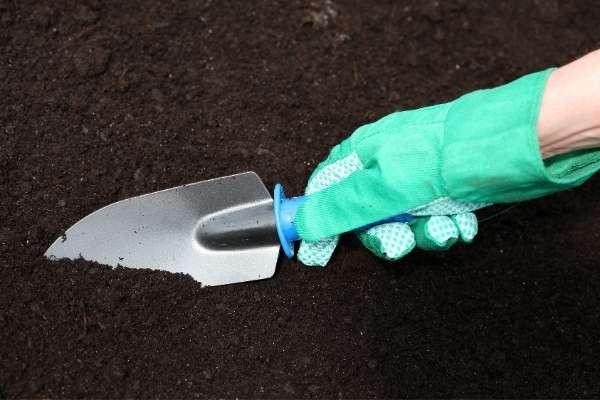
As the first step, we should have to make the soil as it helps to grow cantaloupes on it.
Cantaloupes, watermelons and all cucurbit fruits are likely to grow in acidity soil.
And cantaloupes needs to grow in the soil with 6.0 – 6.5 Ph.
Also cantaloupes need warm and well-drained soil.
Therefore, you need to provide these soil conditions, whether you plant them on the ground, in beds or containers.
For that purpose, the best and cheapest way to prepare the soil is using organic composts.
Because they are:
- Rich with nutrients
- Acidic
- Cheap and DIY
And also because of cantaloupe is a hungry plant, they need to be well-feeded.
Therefore, I’d like to recommend using a slow-release fertilizer to hold the nutrients of the compost for longer.
The other thing is, cantaloupe likes warm soil. How can you provide it, if your garden soil is high in moisture?
It’s easy. You can warm the soil by laying a black plastic layer on the soil.
How does it happen?
Cool man! This is not rocket science.
Black colour can attract more sunlight than others. So it will encourage the soil to keep drained and warm.
Often, gardeners use this methods to try growing fruits and vegetables in highly moist soil like clay.
Step 2: Install the tomato cage
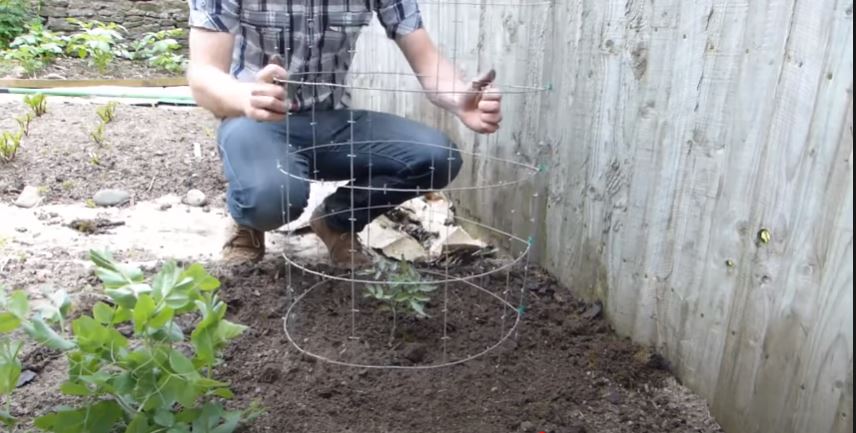
After preparing the soil for growing cantaloupes, then you’ve to install the tomato cage onto the soil.
Actually, there is a special reason why you should complete installing the tomato cage or trellis before you sowing or transplanting cantaloupes.
That’s because cantaloupes and all of the cucurbit plants hate root disturbing.
They’re having a long-running root system, which helps them to produce a huge yield.
But when you installing something like a trellis after they have spread their roots around the soil, can disturb them.
As we all know, a stronger root system will decide the success or failure of a plant.
I think you aren’t willing to grow only a few cantaloupes in a tomato cage.
So when you are using multiple cages you have to make sure that there is a 1.5 feet gap between the two of them.
And the other thing that I need to point out for you is to tie all of the tomato cages together.
By doing this, we are expecting that tomato cages won’t fall onto the ground. And also, it helps to spread the cantaloupe vines in a larger area.
But you don’t require to do like this if you grow cantaloupes in usual trellises.
Step 3: Sow or plant cantaloupes
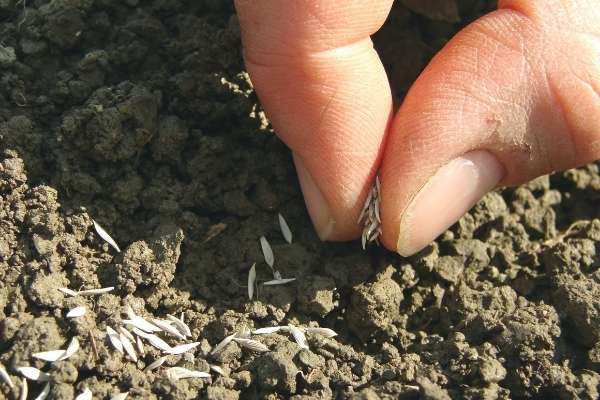
Now after completing the above two steps, you’ve the permission to sow cantaloupe seeds or transplant cantaloupes inside those tomato cages.
If you planting cantaloupes on the ground or in a raised bed, you can bury 3 to 5 seeds or transplant them inside one tomato cage.
And when you sowing the seeds, you’ve to dig an inch deep hole from your finger and bury the seed.
Whether you sow seeds or transplant, to grow cantaloupes in a tomato cage, you shouldn’t plant them on the right middle inside the tomato cage.
Because that doesn’t help cantaloupe plants to practice running on a trellis since they are small.
However, after you’ve sowed or transplanted cantaloupes on the soil, watering it as soon as possible is so important.
When new seeds have been planted, it needs a moist and well-humidity condition to boost out the germination process.
Also when you transplant a plant, you shouldn’t straightly expose it to high warm conditions.
We are giving some time to reduce the transplanting shock.
So despite that cantaloupes are warm and sun-loving plants and hold the moisture of the soil for a healthy level for germination and growing process.
Step 4: Fertilize the soil

Cantaloupes, which are a variety of the Cucurbits family has been recognized as a heaving feeding plant.
That’s why compost soil is ideal for growing cantaloupes and many Cucurbits plants like melon and squash.
But even if you planted cantaloupes in nutrient-rich compost soil, with slow-release fertilizers, using external fertilizers can double up the yield.
So I like to recommend you to use external fertilizer after the cantaloupe plant has grown up to at least 3.5″ inches tall.
In the beginning, you can use a high-nitrogen fertilizer, which will encourage the plant to sprout more leaves and bloom flowers more quickly.
This 28-0-0 high Nitrogen fertilizer did wonders in my vegetable garden, which was listed as really affordable on Amazon.
Unless using this nitrous fertilizer, I don’t push you to use more fertilizers to treat your soil.
Because over-fertilizing the soil will never help a cantaloupe plant for grow and produce a good yield.
Remember this also,
You have to control the using dosage of that nitrous fertilizer when your cantaloupe plant growing more leaves and bloomed many flowers.
Because when the plant has bloomed many flowers, we just want to turn those flowers on to fruits. Not to encourage the plant for more leaves or flowers.
So when your cantaloupe plant getting to that stage, gently reduce the dosage of nitrogen you’re mixing with water.
Then stop using it anymore.
Step 5: Train cantaloupes to run on the trellis
This is the most important step if you want to grow cantaloupes in a tomato cage vertically.
Actually, you can’t just grow melons or cantaloupes vertically on a trellis without training them.
Because they are naturally running on the ground, you need to adapt them to grow vertically.
To make things happen easier, cantaloupes are naturally producing tendrils on their stem, which can coil up on anything they touch.
Therefore, you need to study the growing of your plant.
As a vertical growing practice, you can tie those tendrils onto the trellis or the tomato cage. It will help the cantaloupe plant to keep running vertically.
And also, you can loosely tie up the over growing stems on to the tomato cage from a twine.
Over time, if you care about giving out the best chance for growing cantaloupes in a tomato cage like that, they won’t grow here and there on the trellis.
Otherwise, cantaloupe vine will grow anywhere for getting sunlight on their leaves.
Step 6: Harvest your lovely cantaloupes

This is the most happiest step of growing cantaloupes in a tomato cage is the time you are harvesting them.
Usually, cantaloupes are looking in golden colour and averagely they are in 3 pounds when they are ready to harvest.
Averagely cantaloupes are ready to be harvested after 75 to 90 days after they have been planted.
But these numbers can get low or extended based on factors like,
- Sunlight they getting
- Nutrients of the soil
- Pollinating
- The method used to grow (seeds/transplants)
Your cantaloupe is ready to harvest and it’s well-ripened if you can see the below signals.
- Tendrils near the fruit are brown
- The stem near the fruit is brown in colour
- The fruit has turned brown or golden in colour
Mostly, your cantaloupe plant will produce fruits in the summer season.
So whenever you can see that there are enough fruits have produced by the flowers, you can cut off the flower buds on the tree at that time.
By doing that you are giving the best chance to mature cantaloupes on the plant.
And when you are harvesting cantaloupes, make sure you don’t hurt the vine.
Don’t just pull off the fruit off the vine. Pick off the fruit while you gently twisting it.
Now you’re able to taste a nice cantaloupe.
Watering needs for cantaloupes
Even you should grow cantaloupes in warm conditions, cantaloupe is a plant that requires plenty of water.
Here are the Numbers.
If you are in an area that has enough rainfall, one inch of rainfall water per week will be enough for a cantaloupe plant.
But if not, the average watering is 2 inches per week.
Here’s how you determine it.
Because the cantaloupe plants are growing in warm conditions, often their leaves can be wilted in the afternoon. And they will turn back for green at night.
But if your vertical growing cantaloupe plants don’t turn back to their original color, your plant needs more water.
Then you have to water it the next morning. Don’t water them at night.
Whenever you’re watering cantaloupes, hold watering more onto the soil as the water soaks in deeply of the soil.
Because of cantaloupes having longer roots, water should soak into at least 4 inches deep.
Also, remember you have to water onto the soil. Not for the leaves, which can be caused for diseases like powdery mildew.
When your tomato cage growing cantaloupe plants are in the season of producing fruit, you have to cut down the watering 2 weeks before the fruit is ripening. By doing that you’re giving the best chance to concentrate enough sugar on to the melon which also makes it sweet.
You can have more information on watering cantaloupes from backyard-vegetable-gardening.com, which also helps me with some information.
Cantaloupe plant care when growing in tomato cages
Thankful to my personal experience of growing cantaloupes in tomato cages and trellises, I have recognized that there are many situations that we have to look out our cantaloupe plants with extra care.
Here are some tips to care your cantaloupe plant while you growing it.
Diseased leaves

Cucurbits plant owners are able to see diseases on plants very often.
Here are some of them,
- Leaf miner
- Leaf rust
- Stem rust
- Powdery mildew
- Fungal attacks
Maybe in the process of growing cantaloupes in tomato cages, you’ll be able to see these diseases on your plant also.
However, if you can see them on your cantaloupe plant, you have to cut them off as soon as possible.
Because if they are staying on the plant for a long time, that disease can spread over to other leaves of your cantaloupe melon plant.
Here’s the perfect article I’ve ever seen about identifying and managing cantaloupe and melon diseases.
Pollinating
Pollinating is an important process that helps plants to produce more fruits.
Mostly in vegetable gardening, pollinating is happened by the wind and from the insects.
And when we considering pollinating when you are growing cantaloupes in vertical trellises, you are going to do well rather than just growing them horizontally.
Because most of the flowers are staying in the air, they are able to have better contact with the air than ever.
More air movement gives more opportunity to pollinate.
And also vertically bloomed flowers are getting more attracted by bees and butterflies, which tend to pollinate on them.
Even above two methods can happen naturally on your cantaloupe plant, I recommend you to hand pollinate the flowers on your own.
It will make things happen faster.
Pests/insects control
While you are growing such a nice fruit like cantaloupe, pests and insects are jealous of that plant.
But remember, your vertical growing cantaloupe plant will be get hurt by insects more than from pests like caterpillars.
So, the easiest way to get rid of those pests and insects is by sprinkling some wood ash on the leaves and the soil of the plant.
It’s a fine way to repel insects. Here’s a perfect guide I wrote about insect repelling by using ash.
But don’t get hesitated to use ash on your cantaloupe plant, because of the anti-acidic quality of wood ashes.
A little dosage can almost do nothing with the Ph of the plant and the soil.
I was so surprised with this, Cutter Backyard Bug Controller I use. It has been working so much really well on every type of bug and harmful insects. I highly recommend you to take a look at that on Amazon from here, which is way cheap as much as 13 bucks!!
Supporting cantaloupes
A ripen cantaloupe is an averagely of 3 pounds.
So when you are rowing cantaloupes on tomato cages, they could be fall over because of their weight and gravity.
Therefore you have to use support to keep them hanging on the plant and the trellis.
And the thing is you shouldn’t use the usual wood sticking support.
You are using a sling to support the big cantaloupes so as not to fall over.
Often many gardeners are doing it on their own by using a T-shirt. And it works against gravity.
So you can also make a free melon sling to support your cantaloupes by watching this video.
Why use tomato cages/ trellis to grow cantaloupes?
As I said to you before in this article, there are some specific reasons that you should grow cantaloupes in tomato cages and trellises rather than just running on the ground.
Let’s talk about them.
Survives the plant from diseases
Including cantaloupes and watermelon, many cucurbit varieties are often facing diseases on the plant.
The most popular ones are rotted leaves and fungal attacked leaves.
The main reason to occur these diseases on the plant is, not getting enough sunlight and air movement on leaves.
But when you grow cantaloupes vertically on a trellis or tomato cage, You don’t have to worry about lack of sunlight and air movement.
Low pests damage
This is an awesome advantage that you are only getting by growing cantaloupes vertically.
Here’s the deal
When you are growing a plant vertically on a trellis, almost all the leaves of the plant staying in the air.
So it will definitely cut down the probability of getting your cantaloupe plant damaged by pests.
Less space & more fruit
Undoubtedly, you have to accept that growing cantaloupe in tomato cages and trellises save you space rather than just leave to run on the ground.
While they required less space, they will also produce more fruits more than just leaving on the ground.
Here’s why?
Growing cantaloupes vertically can save the plant from some general diseases.
And also it will provide sunlight for the leaves and flowers better than ever, which tends to grow new flowers and leaves.
Meanwhile plant is growing up healthier than you grow it horizontally.
Eventually, the plant grows more fruits in less space, if you grow cantaloupes in a tomato cage.
